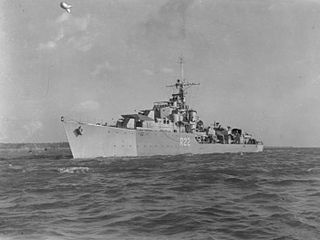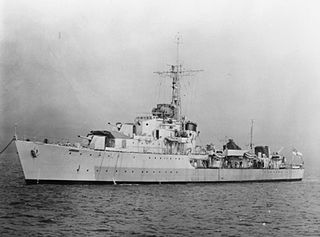
HMS Black Swan, was the name ship of the Black Swan-class sloops of the Royal Navy. This class was admired for its sea-going qualities.

HMS Eskimo was a Tribal-class frigate of the Royal Navy in service from 1963 to 1980. She was scrapped in 1992.

HMS Battleaxe was a Weapon-class destroyer of the Royal Navy, completed just after the Second World War.

HMS Broadsword was a Weapon-class destroyer of the British Royal Navy in service from 1948 and scrapped in 1968.

HMS Undine was a U-class destroyer of the British Royal Navy that saw service during World War II. On 27 March 1945, HMS Undine detached from RN Fast Carrier TF57 to rescue the airmen of a downed RN TBF Avenger aircraft also rescued a USN Corsair pilot adrift for two days south of the Sakishima Gunto in the Philippine Sea.

HMS Ursa was a U-class destroyer of the Royal Navy that saw service during the Second World War. She was later converted into a Type 15 fast anti-submarine frigate, with the new pennant number F200.

The second HMS Whirlwind was a W-class destroyer of the British Royal Navy and was built by Hawthorn Leslie and was launched on 30 August 1943. She saw service during World War II and the Cold War.

HMS Mermaid was a Modified Black Swan-class sloop of the Royal Navy. Mermaid saw service as a convoy escort during the Second World War, taking part in the sinking of two German submarines while escorting Arctic convoys to and from the Soviet Union.

HMS Tetcott was a Type II British Hunt-class destroyer built for the Royal Navy during World War II. She was the only Royal Navy ship to be named after the Tetcott fox hunt.

The second HMS Vanity was a V-class destroyer of the British Royal Navy that saw service in World War I and World War II.

HMS Albrighton was a Type III Hunt-class destroyer built for the British Royal Navy. She entered service in February 1942, first carrying out an attack on German ships in the English Channel then taking part in the Dieppe Raid, rescuing survivors from the sinking destroyer HMS Broke. Albrighton was next assigned to search for and destroy the German auxiliary cruiser Komet, then escorted a convoy to Gibraltar in prevision of the Allied landings in North Africa. Between December 1942 and April 1943, she participated in the sinking of three more Axis ships with the First Destroyer Flotilla. During the Normandy Landings in June 1944, Albrighton served as a headquarters ship, then sank two German trawlers in the weeks after the invasion. After being converted to a destroyer in early 1945, she was damaged in a collision with a Landing Ship, then was assigned to the British Eastern Fleet. However, the war ended before she was deployed and Albrighton went into reserve.

HMS Chieftain was a C-class destroyer of the Royal Navy that was in service from March 1946, and which was scrapped in 1961.

HMS Cheviot was one of thirty-two C-class destroyers built for the Royal Navy during the Second World War, a member of the eight-ship Ch sub-class. Completed after the war, she was sold for scrap in 1962.

HMS Chequers was a C-class destroyer, of the "Ch" subclass, of the Royal Navy that was in service from December 1945, and which was scrapped in 1966.

HMS Chivalrous was one of thirty-two C-class destroyers built for the Royal Navy during the Second World War, a member of the eight-ship Ch sub-class. Commissioned in 1946, she was built as a flotilla leader with additional accommodation for staff officers. The ship was loaned to the Pakistani Navy during the late 1950s and was sold for scrap in 1961 after being returned.

HMS Eggesford was a Type III Hunt-class destroyer of the Royal Navy. She entered service in January 1943, carrying out convoy escort, patrol and anti-shipping attacks for most of the rest of the Second World War. In 1957, she was sold to the West German Navy, serving as a training ship for the submarine weapons school until 1968.

HMS Peacock was a modified Black Swan-class sloop of the Royal Navy. She was built for service as a convoy escort during the Second World War, serving in the arctic and Atlantic convoys. After the Second World War she saw service in the Mediterranean. She was scrapped in 1958.
HMS Coreopsis was a Flower-class corvette, built for the Royal Navy during the Second World War which served in the Battle of the Atlantic. In 1943, she was transferred to the Royal Hellenic Navy as RHNS Kriezis and participated in the 1944 Invasion of Normandy. Shortly before she was scrapped, she took part in the British war film, The Cruel Sea.
HMS Talybont was a Type III Hunt-class escort destroyer who served in the Royal Navy. She was launched in February 1943 and completed in May that year, serving for the rest of the Second World War. She took part in the Normandy Landings in June 1944, supporting the landings at Omaha Beach and the Pointe du Hoc. Post war she served in the Mediterranean before being reduced to reserve at the end of 1947. She was sold for scrap in 1961, with disposal completed by 1962.

HMS Modeste was a modified Black Swan-class sloop of the British Royal Navy. She was built by Chatham Dockyard, during the Second World War, being launched on 29 January 1944 and commissioned on 3 September 1945. Post war, Modeste served with the British Far East Fleet, and took part in the Suez Crisis. She was paid off into reserve for the last time in 1958 and scrapped in 1961.


















